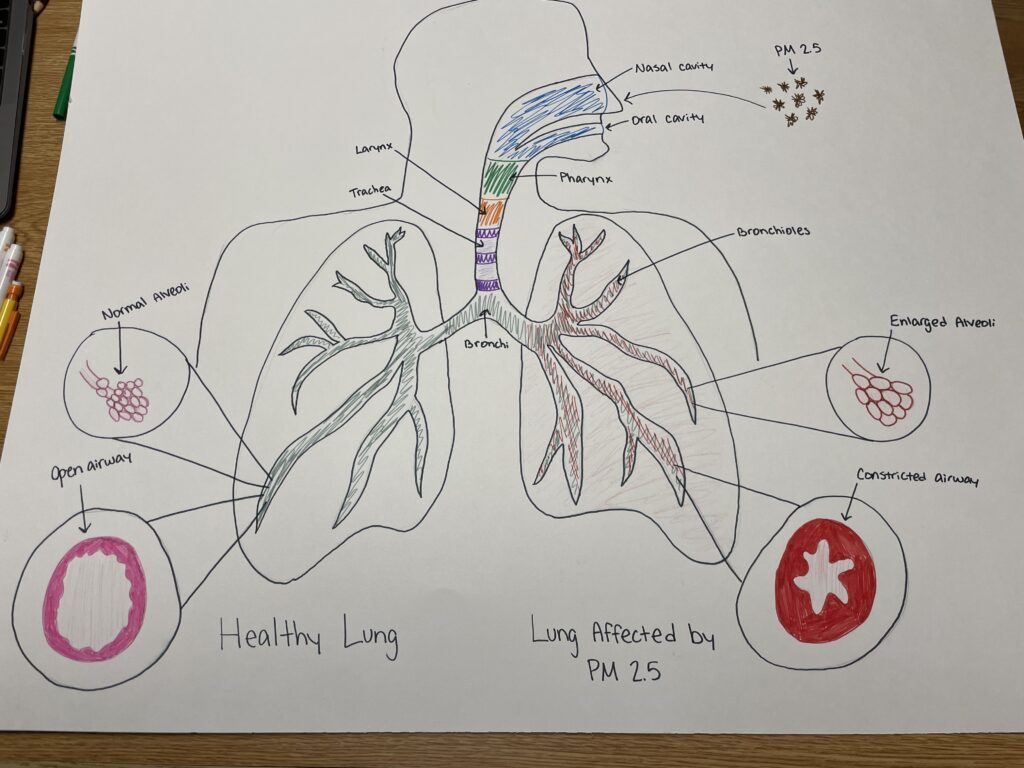
My STEAM project is on particulate matter (PM) 2.5 and its effects on the respiratory system, including symptoms and possible development of chronic respiratory diseases. The objective I will be focusing on is to analyze the effects of disease on function and structure of the respiratory system. I have drawn out how PM 2.5 travels through the respiratory system and can affect the structure and function of this system. PM 2.5 is defined as dust that is measured <10 µm (Kyung and Jeong 2020). This “dust” can be composed of a mix of different and complex compounds, including solid and liquid compounds that can also be organic or inorganic (Ziou et al. 2022). It can be produced by emissions of many different things, such as gasoline, diesel, oil, or even wood (California Air Resources Board). When looking at my drawing, you can see how PM 2.5 is able to travel through inhalation, starting at the nose or mouth then travels to the pharynx, then larynx, then the trachea. From there, it is divided into the right and left lung by the bronchi and finally completes its path to the alveoli, located at the end of the bronchioles, where gas exchange between oxygen and carbon dioxide takes place. Because of particulate matter 2.5’s small size it can be easily inhaled by humans and can become dislodged in the alveoli of the lungs, raising concern in certain locations where exceeding levels of air pollution is a concern, including in Fairbanks. The issue of PM 2.5 in Fairbanks derives from specifically wood burning, burning of oil, industrial sources, and mobile emissions (Division of Air Quality). Because of particulate matter’s long term existence in the alveoli it can promote inflammation of the lungs and affect how the lungs function, increasing the risk of developing chronic respiratory diseases such as chronic obstructive pulmonary disease, asthma, and lung cancer (Ziou et al. 2022, Yang et al. 2020). Developing these diseases can affect the function of a person’s lungs by affecting the rate of diffusion in which gas exchange occurs, increasing the inflammation of a person’s airway, coughing, wheezing, increasing the rate of developing respiratory infections, and more (Yang et al. 2020, Kyung and Jeong 2020). In my drawing, I have drawn out the process in which particulate matter 2.5 enters a human body, which is color coded in brown, as it travels through the respiratory system by starting with the oral and nasal cavity. To represent the nasal and oral cavity I have drawn them in blue. To represent the pharynx I color coded that portion green. To represent the larynx I have chosen to use the color orange. To represent the trachea I’ve drawn it in the color purple. For the bronchi/bronchioles I have used the color gray. Lastly, to represent healthy alveoli and lung tissue I have used the color pink, while I chose to use the color red to represent inflammation in the lungs and alveoli.
Citations
California Air Resources Board. Inhalable Particulate Matter and Health (PM2.5 and PM10) | California Air Resources Board. (n.d.). https://ww2.arb.ca.gov/resources/inhalable-particulate-matter-and-health#:~:text=PM10%20and%20PM2.5%20often,a%20significant%20proportion%20of%20PM10.
Fairbanks – Particulate Matter. Division of Air Quality. (n.d.). https://dec.alaska.gov/air/anpms/communities/fbks-particulate-matter/
Kyung SY, Jeong SH. Particulate-Matter Related Respiratory Diseases. Tuberc Respir Dis (Seoul). 2020 Apr;83(2):116-121. doi: 10.4046/trd.2019.0025.
Yang, L., Li, C., & Tang, X. (2020, February 4). The impact of PM2.5 on the host defense of respiratory system. Frontiers. https://www.frontiersin.org/articles/10.3389/fcell.2020.00091/full#:~:text=Exposure%20to%20PM2.5%20can%20cause%20the%20development%20and%20progression,%2C%202015)%2C%20chronic%20obstructive%20pulmonary
Ziou M, Tham R, Wheeler AJ, Zosky GR, Stephens N, Johnston FH. Outdoor particulate matter exposure and upper respiratory tract infections in children and adolescents: A systematic review and meta-analysis. Environ Res. 2022 Jul;210:112969. doi: 10.1016/j.envres.2022.112969.

Your STEAM project is like a bright flashlight shining on a problem affecting our health: dirty air. Specifically, you’re looking at how tiny particles called PM 2.5 mess with our breathing. These particles come from all sorts of places, like cars, factories, and even burning wood in fireplaces. When we breathe, these little particles hitch a ride into our bodies. They travel deep into our lungs, kind of like taking a journey through tunnels. First, they enter through our nose or mouth, then pass through places like the throat (pharynx), voice box (larynx), windpipe (trachea), and smaller airways (bronchi) until they finally reach the tiny air sacs in our lungs called alveoli. Once inside our lungs, these particles can cause trouble. They make our lungs inflamed, like when you get a bump or scrape that gets red and sore. Over time, this inflammation can make it harder for us to breathe well. And if these particles hang around for a long time, they can even lead to serious health problems like asthma, COPD, or lung cancer. I love how you’re using cool visuals to show exactly how these particles move through our lungs and cause problems. By using different colors to highlight where the trouble spots are, you’re making it easier for everyone to see and understand. Ultimately, your project isn’t just about pointing out a problem, it’s about finding solutions. By raising awareness about how dirty air hurts our lungs, you’re helping push for changes that can make our air cleaner and our lungs healthier. And that’s something we can all breathe a little easier about.